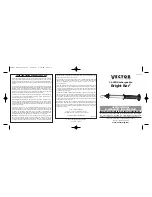
Page 3
RULES FOR SAFE OPERATION (Continued)
SAFETY RULES FOR FLASHLIGHTS
WARNING:
Do not operate flashlight or charger near flammable
liquids or in gaseous or explosive atmospheres. Internal
sparks may ignite fumes.
WARNING:
Lens and bulb become hot during use:
•
During or immediately after use, don't lay flashlight
flat on lens surface or place lens area in contact with
a plastic or fabric covered surface.
•
Handle flashlight with care around any flammable
surface.
•
Let flashlight cool for several minutes after use before
changing bulb.
•
Do not use or permit use of flashlight in bed or sleeping
bags. This flashlight lens can melt fabric and a burn
injury could result.
IMPORTANT SAFETY RULES FOR BATTERY
TOOLS
■
USE ONLY THE CHARGER RECOMMENDED FOR
USE WITH YOUR FLASHLIGHT.
Do not substitute
any other charger. Use of another charger could cause
batteries to explode causing possible serious injury.
■
Your battery tool should be charged in a location where
the temperature is more than 50
°
F but less than 100
°
F.
■
Under extreme usage or temperature conditions, battery
leakage may occur. If liquid comes in contact with your
skin, wash immediately with soap and water, then
neutralize with lemon juice or vinegar. If liquid gets in
your eyes, flush them with clean water for at least 10
minutes, then seek immediate medical attention.
WARNING:
Batteries vent hydrogen gas and can explode in the
presence of a source of ignition, such as a pilot light. To
reduce the risk of serious personal injury, never use any
cordless product in the presence of open flame. An
exploded battery can propel debris and chemicals. If
exposed, flush with water immediately.
WARNING:
Never use a battery pack that has been damaged or
received a sharp blow. A damaged battery pack is
subject to explosion. Properly dispose of a damaged
battery pack immediately. Failure to heed this warning
can result in serious personal injury.
■
WHEN SERVICING USE ONLY IDENTICAL
REPLACEMENT PARTS.
IMPORTANT SAFETY INSTRUCTIONS
FOR CHARGER
■
Before using battery charger, read all instructions and
cautionary markings in this manual, on battery charger,
and product using battery charger.
CAUTION:
To reduce the risk of injury, charge only nickel-cadmium
type rechargeable batteries. Other types of batteries
may burst causing personal injury and damage.
■
Do not expose to wet or damp conditions.
■
To reduce the risk of damage to charger body and cord,
pull by charger plug rather than cord when disconnecting
charger.
■
An extension cord should not be used unless absolutely
necessary. Use of improper extension cord could result
in a risk of fire and electric shock. If extension cord must
be used, make sure:
a. That pins on plug of extension cord are the
same number, size and shape as those of
plug on charger.
b. That extension cord is properly wired and in
good electrical condition; and
c.
That wire size is large enough for AC ampere rating
of charger as specified below:
Cord Length (Feet) 25' 50' 100'
Cord Size (AWG) 16 16 16
Note:
AWG = American Wire Gage
■
DO NOT OPERATE CHARGER WITH A DAMAGED
CORD OR PLUG.
If damaged, have replaced
immediately by a qualified serviceman.
■
Do not operate charger if it has received a sharp blow,
been dropped, or otherwise damaged in any way; take
it to a qualified serviceman.
■
Do not disassemble charger; take it to a qualified
serviceman when service or repair is required. Incorrect
reassembly may result in a risk of electric shock or fire.
■
To reduce the risk of electric shock, unplug charger
from outlet before attempting any maintenance or
cleaning. Turning off controls will not reduce this risk.
■
Do not use charger in wet or damp conditions.
■
Disconnect charger from power supply when not in use.
■
SAVE THESE INSTRUCTIONS.
Review them
frequently and use them to instruct others who may use
this light. If you loan someone this light, loan them these
instructions also.
SAVE THESE INSTRUCTIONS
Содержание FL96
Страница 7: ...Page 7 NOTES...


























